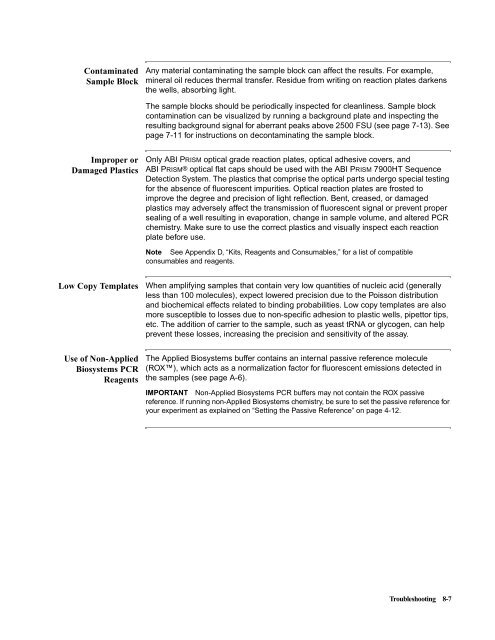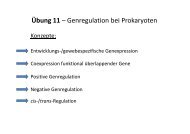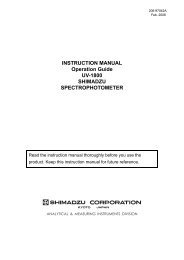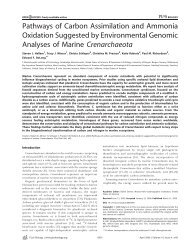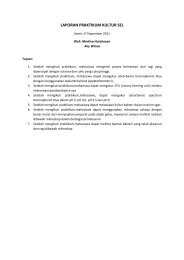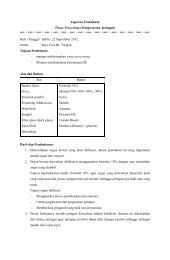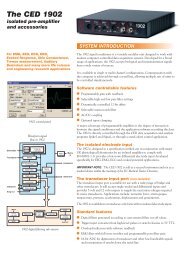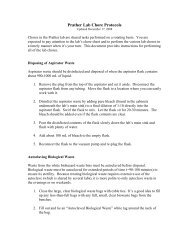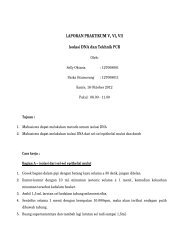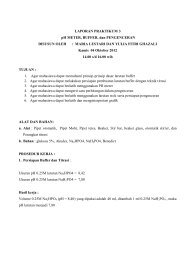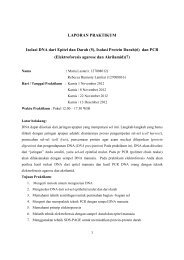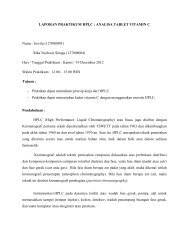ABI Prism® 7900HT Sequence Detection System ... - OpenWetWare
ABI Prism® 7900HT Sequence Detection System ... - OpenWetWare
ABI Prism® 7900HT Sequence Detection System ... - OpenWetWare
Create successful ePaper yourself
Turn your PDF publications into a flip-book with our unique Google optimized e-Paper software.
Contaminated<br />
Sample Block<br />
Improper or<br />
Damaged Plastics<br />
Any material contaminating the sample block can affect the results. For example,<br />
mineral oil reduces thermal transfer. Residue from writing on reaction plates darkens<br />
the wells, absorbing light.<br />
The sample blocks should be periodically inspected for cleanliness. Sample block<br />
contamination can be visualized by running a background plate and inspecting the<br />
resulting background signal for aberrant peaks above 2500 FSU (see page 7-13). See<br />
page 7-11 for instructions on decontaminating the sample block.<br />
Only <strong>ABI</strong> PRISM optical grade reaction plates, optical adhesive covers, and<br />
<strong>ABI</strong> PRISM® optical flat caps should be used with the <strong>ABI</strong> PRISM <strong>7900HT</strong> <strong>Sequence</strong><br />
<strong>Detection</strong> <strong>System</strong>. The plastics that comprise the optical parts undergo special testing<br />
for the absence of fluorescent impurities. Optical reaction plates are frosted to<br />
improve the degree and precision of light reflection. Bent, creased, or damaged<br />
plastics may adversely affect the transmission of fluorescent signal or prevent proper<br />
sealing of a well resulting in evaporation, change in sample volume, and altered PCR<br />
chemistry. Make sure to use the correct plastics and visually inspect each reaction<br />
plate before use.<br />
Note See Appendix D, “Kits, Reagents and Consumables,” for a list of compatible<br />
consumables and reagents.<br />
Low Copy Templates When amplifying samples that contain very low quantities of nucleic acid (generally<br />
less than 100 molecules), expect lowered precision due to the Poisson distribution<br />
and biochemical effects related to binding probabilities. Low copy templates are also<br />
more susceptible to losses due to non-specific adhesion to plastic wells, pipettor tips,<br />
etc. The addition of carrier to the sample, such as yeast tRNA or glycogen, can help<br />
prevent these losses, increasing the precision and sensitivity of the assay.<br />
Use of Non-Applied<br />
Biosystems PCR<br />
Reagents<br />
The Applied Biosystems buffer contains an internal passive reference molecule<br />
(ROX), which acts as a normalization factor for fluorescent emissions detected in<br />
the samples (see page A-6).<br />
IMPORTANT Non-Applied Biosystems PCR buffers may not contain the ROX passive<br />
reference. If running non-Applied Biosystems chemistry, be sure to set the passive reference for<br />
your experiment as explained on “Setting the Passive Reference” on page 4-12.<br />
Troubleshooting 8-7


